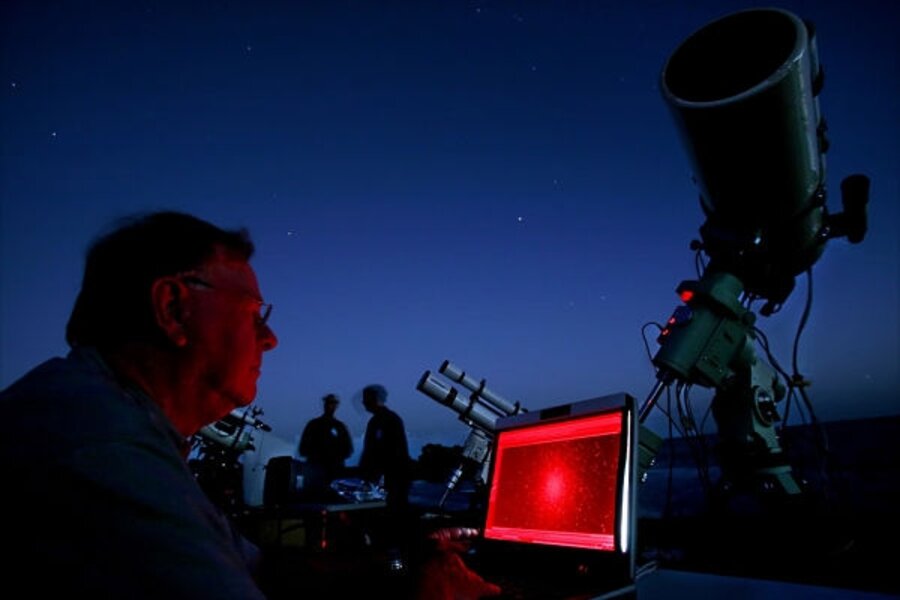NASA's planet hunters enlist backyard astronomers
Loading...
NASA's Kepler mission to spot Earth-like planets in Earth-like orbits around sun-like stars (one more "like" in this sentence and my artistic license will be revoked) is reaching out to amateur astronomers for help.
During a pre-flight press briefing a few weeks back, the mission's lead scientist, William Borucki, noted that amateurs with the right equipment and a lot of patience could help top off Kepler's anticipated discoveries. (You can read more about the mission here and here.)
As Dr. Borucki explains it, some planets around these stars will be more like Neptune or Jupiter and larger. Kepler may only snag one or two transist during its mission, rather than the three per planet it's aiming for. One transit is tantalizing, but not enough to claim: "I've got one!"
If Kepler ends with a batch of stars that have only one transit to their credit, that represents unfinished business.
So, Borucki says, "we're going to take the data that we didn't have confirmations for, we've only seen one transit or two transits, and ground-based people, whether amateurs or whether professionals, can follow up and find that third transit and make a discovery. Many discoveries will be made with the data we give to the public after the mission ends."
That may be a long time to wait for a crack at planet-hunting, so in the meantime, astronomer Greg Laughlin has a suggestion. Pitch in on Transitsearch.
For the story behind the program, you can read more here. But the thumbnail: Amateurs using readily available telescopes, software, and CCD cameras on the back of their 'scopes are hunting for transiting planets around some of the nearest, brightest stars.
They know which stars to watch and when to look because the presence of a planet and its orbital period already are known, thanks to professional astronomers who have detected a planet's presence by measuring the slow-mo rumba the planet imparts to the spectrum of its host star.
But this so-called radial-velocity technique will tell astronomers only so much about a planet -- its orbital period and mass. The transit approach -- measuring how the starlight dims as the planet swings across its surface, adds more. The depth of dimming yields an accurate measure of the planet's size, and the transit also reveals the tilt of the planet's orbit with respect to the star's equator.
Run the numbers, and you can now estimate the planet's density -- which tells you whether it's rocky or not.
And the inclination information can spin a yarn all its own.
Case in point: a planet dubbed HD80606B. During a phone chat the other day, Dr. Laughlin described the Valentine's Day discovery that HD80606B is a transiting planet. It's some 190 light years away. You can read a running account of the discovery's progress here.
It was discovered in 2001, and astronomers calculated that it has an extremely elliptical orbit, almost like a comet's. But the transit information from a network of amateurs suggests that the orbit is strongly tilted compared with the star's equator. In our solar system by contrast, the planets' orbits all fall within 7 degrees of an imaginary plane through the sun's equator.
Laughlin, an astrophysicist at the University of California at Santa Cruz, says that if observations of an additional transit confirm the planet's orbital tilt, "that tells you there was a violent event in the formation of the system." He suggests that it may have something to do with the presence of a distant binary star -- distant, but just close enough where it's gravity persistently drove the planet's orbital tilt higher and higher.
And now that the planet is known to be a transiting planet, professionals can try to detect in rough terms the planet's atmosphere. They do this by taking detailed spectra of the star alone, then of the star and planet as the planet passes in front of the star. Subtract the two spectra, and voila, you have the planet's spectra.
UPDATE:
In an email exchange, Todd Klaus, with the Kepler Science Operations Center at NASA's Ames Research Center at Moffett Field in California notes that amateurs will most likely be able to bag planets large enough to knock a stars light back by at least 1 percent. He writes that from his own backyard observatory, with a 12.5-inch telescope, he's tracked a planet that dimmed its star by about 3 percent.
This means amateurs could be batting clean-up big time on so-called hot Jupiters, planets with Jupiter's mass or more that orbit very close to their host stars.





